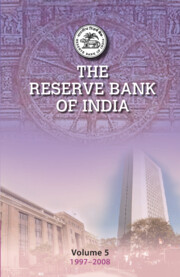Book contents
- Frontmatter
- Contents
- Tables
- Boxes
- Foreword
- Preface
- Acknowledgements
- List of Abbreviations
- 1 Introduction: Managing Liberalisation
- 2 The Macroeconomic Context
- 3 Monetary Management
- 4 Foreign Exchange Market and Management of the Capital Account
- 5 Foreign Exchange Reserves Management
- 6 Financial Markets
- 7 Public Debt Management
- 8 The Payment and Settlement Systems
- 9 Currency Management
- 10 Regulation of the Financial System – Part I: Commercial Banks
- 10 Regulation of the Financial System Part II: Other Financial Institutions
- 11 Supervision of the Financial System
- 12 Rural Credit
- 13 Financial Inclusion
- 14 Communication Policy
- 15 Organisational Change
- Appendices
- Photographs
- Select Bibliography
- Index
8 - The Payment and Settlement Systems
Published online by Cambridge University Press: 10 January 2023
- Frontmatter
- Contents
- Tables
- Boxes
- Foreword
- Preface
- Acknowledgements
- List of Abbreviations
- 1 Introduction: Managing Liberalisation
- 2 The Macroeconomic Context
- 3 Monetary Management
- 4 Foreign Exchange Market and Management of the Capital Account
- 5 Foreign Exchange Reserves Management
- 6 Financial Markets
- 7 Public Debt Management
- 8 The Payment and Settlement Systems
- 9 Currency Management
- 10 Regulation of the Financial System – Part I: Commercial Banks
- 10 Regulation of the Financial System Part II: Other Financial Institutions
- 11 Supervision of the Financial System
- 12 Rural Credit
- 13 Financial Inclusion
- 14 Communication Policy
- 15 Organisational Change
- Appendices
- Photographs
- Select Bibliography
- Index
Summary
Introduction
A payment system is defined as ‘a system that enables payment to be effected between a payer and a beneficiary, involving clearing, payment or settlement service or all of them, but does not include a stock exchange’, and includes ‘the systems enabling credit card operations, debit card operations, smart card operations, money transfer operations or similar operations’. Settlement means ‘settlement of payment instructions and includes the settlement of securities, foreign exchange or derivatives or other transactions which involve payment obligations’ (Payment and Settlement Systems Act, 2007). Clearing operations are subsumed in payment and settlement systems. A standard classification of the payment and settlement systems relevant for the reference period is shown in Table 8.1.
The economic liberalisation process had led to growth and innovation in financial markets, as well as increased risks. Responding to these challenges and opportunities, the Reserve Bank redesigned and developed the payment and settlement infrastructure. Several major initiatives had begun before 1997, including the introduction of magnetic ink character recognition (MICR) technology, electronic clearing service (ECS), electronic funds transfer (EFT) and delivery versus payment (DvP) in government securities transactions. In the capital market, the National Securities Depository Ltd. (established in 1996) pioneered dematerialisation of securities. In 1996, the Bank set up the Institute for Development and Research in Banking Technology (IDRBT) in Hyderabad. From 1 January 1995, the Bank carved out a separate department, the Department of Information Technology (DIT) out of the Management Services Department. Until 2005, the DIT oversaw initiatives based on information technology (IT) within the Bank and the industry, and improved the infrastructure of the payment-and-settlement-related services. The organisational evolution culminated in March 2005 with the establishment of the Department of Payment and Settlement Systems (DPSS) and a Board for Regulation and Supervision of Payment and Settlement Systems (BPSS). A Payment and Settlement Systems Act, 2007, accorded regulatory and supervisory powers to the Bank over all payment systems in the country.
This chapter outlines the major initiatives undertaken and implemented by these bodies during the reference period to improve speed, convenience, efficiency and safety in financial transactions.
The System in 1997–98
The banking network as at the end of March 1998 consisted of 66,306 bank offices belonging to 299 commercial banks (27 in the public sector, 34 in the private sector, 42 foreign banks and 196 regional rural banks) .
- Type
- Chapter
- Information
- The Reserve Bank of IndiaVolume 5, 1997–2008, pp. 286 - 335Publisher: Cambridge University PressPrint publication year: 2023



